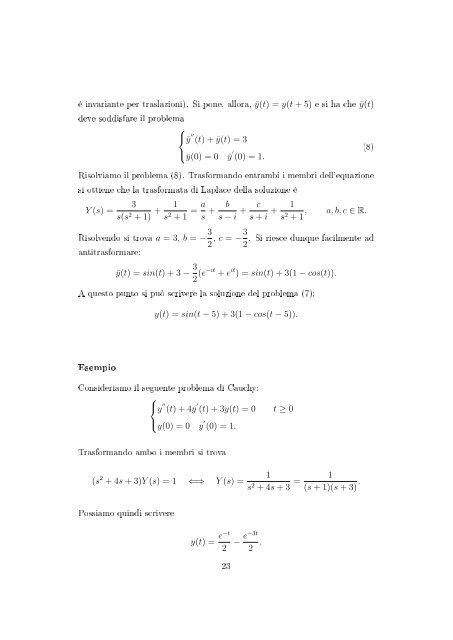1 La trasformata di Laplace
1 La trasformata di Laplace
1 La trasformata di Laplace
- No tags were found...
Create successful ePaper yourself
Turn your PDF publications into a flip-book with our unique Google optimized e-Paper software.
è invariante per traslazioni). Si pone, allora, ȳ(t) = y(t + 5) e si ha che ȳ(t)deve sod<strong>di</strong>sfare il problema⎧⎨ȳ ′′ (t) + ȳ(t) = 3⎩ȳ(0) = 0 ȳ ′ (0) = 1.Risolviamo il problema (8). Trasformando entrambi i membri dell'equazionesi ottiene che la <strong>trasformata</strong> <strong>di</strong> <strong>La</strong>place della soluzione èY (s) =3s(s 2 + 1) + 1s 2 + 1 = a s +bs − i +cs + i + 1 , a, b, c ∈ R.s 2 + 1Risolvendo si trova a = 3, b = − 3 2 , c = −3 . Si riesce dunque facilmente ad2antitrasformare:ȳ(t) = sin(t) + 3 − 3 2 (e−it + e it ) = sin(t) + 3(1 − cos(t)).A questo punto si può scrivere la soluzione del problema (7):y(t) = sin(t − 5) + 3(1 − cos(t − 5)).(8)EsempioConsideriamo il seguente problema <strong>di</strong> Cauchy:⎧⎨y ′′ (t) + 4y ′ (t) + 3y(t) = 0 t ≥ 0⎩y(0) = 0 y ′ (0) = 1.Trasformando ambo i membri si trova(s 2 + 4s + 3)Y (s) = 1 ⇐⇒ Y (s) =1s 2 + 4s + 3 = 1(s + 1)(s + 3) .Possiamo quin<strong>di</strong> scriverey(t) = e−t2 − e−3t2 .23
















